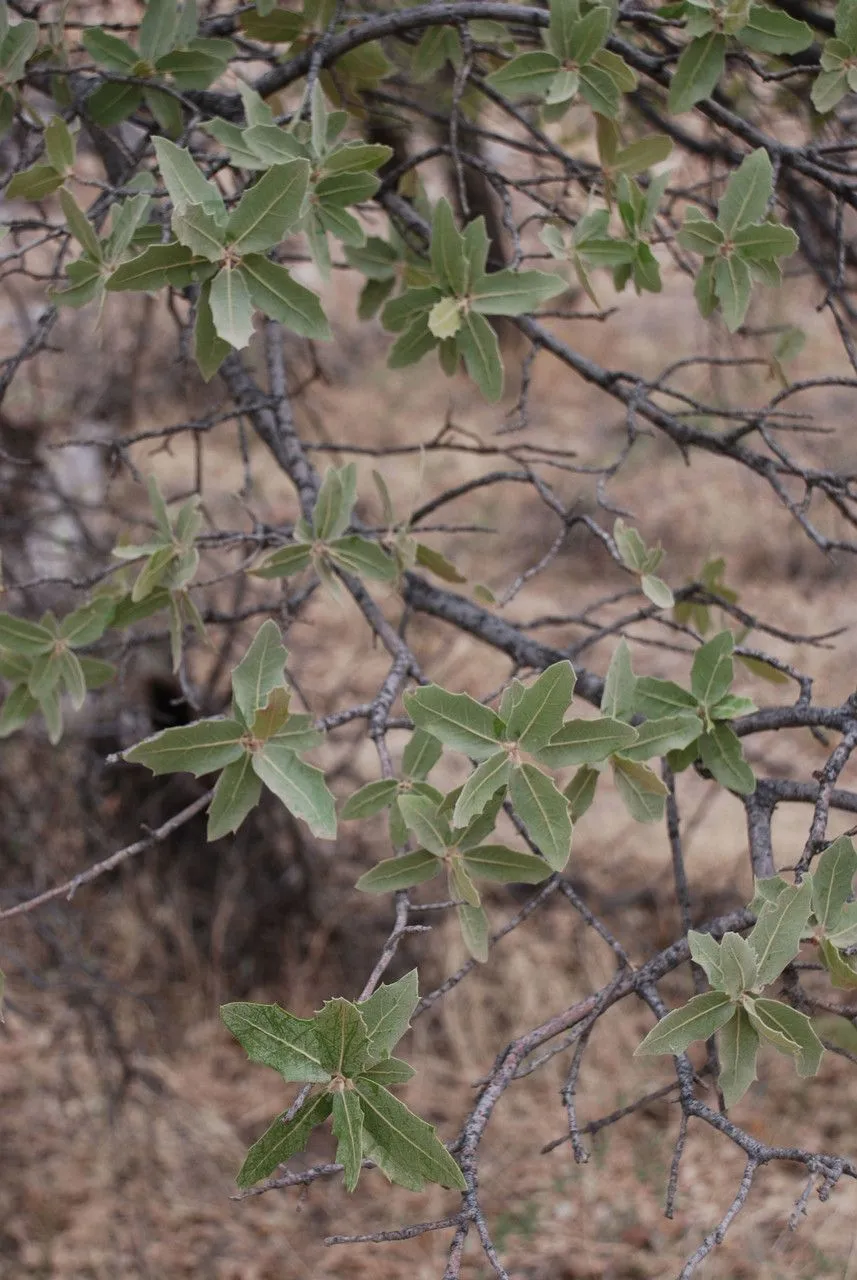
Author: Torr.
Bibliography: W.H.Emory, Not. Milit. Reconn.: 151 (1848)
Year: 1848
Status: accepted
Rank: species
Genus: Quercus
Vegetable: Unknown
Observations: Arizona to W. Texas and N. Mexico
The Emory oak, scientifically known as Quercus emoryi, is a remarkable tree species belonging to the Fagaceae family. This robust oak tree is an integral component of the landscapes stretching from Arizona to West Texas and into Northern Mexico, showcasing the adaptability and persistence of native flora in these regions.
Quercus emoryi is named in honor of William Hemsley Emory, whose meticulous documentation in “Notices of the Military Reconnaissance” in 1848, contributed significantly to its botanical recognition. The species was further described by the botanist John Torrey, adding to the scientific community’s understanding of North American oak species.
The Emory oak is known for its hardy nature and ability to thrive in arid and semi-arid environments. It features an elegant structure, with a robust trunk and sprawling branches adorned with dark green, leathery leaves. The foliage remains evergreen, providing continual coverage and making it an essential species for the local ecosystem.
This oak species is not only significant for its ecological contributions but also holds cultural and practical value to the communities within its range. The acorns produced by Quercus emoryi are a source of food for wildlife and have historically been used by indigenous peoples for their nutritional properties.
In summary, Quercus emoryi, or Emory oak, is a testament to the rich biodiversity of the southwestern United States and northern Mexico. Its enduring presence in these regions highlights the resilience and ecological importance of this esteemed member of the Fagaceae family.
Eng: emory oak, emory’s oak
Spa: bellota
En: Emory oak, Emory’s oak
Fa: بلوط اموری
Es: Bellota
Taken Sep 29, 2022 by Rudd (cc-by-sa)
Taken Oct 29, 2019 by Martinez Correa Joaquin Rodrigo (cc-by-sa)
Taken Oct 30, 2019 by Martinez Correa Joaquin Rodrigo (cc-by-sa)
Taken Jun 21, 2019 by Ordaz Romero Alex Javier Ordaz Romero (cc-by-sa)
Taken Sep 4, 2020 by Echevarria Monica (cc-by-sa)
Taken Oct 29, 2019 by Martinez Correa Joaquin Rodrigo (cc-by-sa)
Taken Oct 30, 2019 by Martinez Correa Joaquin Rodrigo (cc-by-sa)
Taken Apr 30, 2020 by Deborah Ramos (cc-by-sa)
Taken Aug 29, 2012 by EOL − Cavender-Bares, J. (cc-by-nc-sa)
Taken Aug 29, 2012 by EOL − Cavender-Bares, J. (cc-by-nc-sa)
Taken Aug 29, 2012 by EOL − Cavender-Bares, J. (cc-by-nc-sa)
Taken Aug 29, 2012 by EOL − Cavender-Bares, J. (cc-by-nc-sa)
Taken Aug 29, 2012 by EOL − Cavender-Bares, J. (cc-by-nc-sa)
Taken Aug 29, 2012 by EOL − Cavender-Bares, J. (cc-by-nc-sa)
Taken Aug 29, 2012 by EOL − Cavender-Bares, J. (cc-by-nc-sa)
© copyright of the Board of Trustees of the Royal Botanic Gardens, Kew.
© copyright of the Board of Trustees of the Royal Botanic Gardens, Kew.
© copyright of the Board of Trustees of the Royal Botanic Gardens, Kew.
Family: Myrtaceae Author: (F.Muell.) K.D.Hill & L.A.S.Johnson Bibliography: Telopea 6: 402 (1995) Year: 1995 Status:…
Family: Rubiaceae Author: Pierre ex A.Froehner Bibliography: Notizbl. Bot. Gart. Berlin-Dahlem 1: 237 (1897) Year:…
Family: Sapindaceae Author: Koidz. Bibliography: J. Coll. Sci. Imp. Univ. Tokyo 32(1): 38 (1911) Year:…
Family: Asteraceae Author: A.Gray Bibliography: Pacif. Railr. Rep.: 107 (1857) Year: 1857 Status: accepted Rank:…
Family: Fabaceae Author: Medik. Bibliography: Vorles. Churpfälz. Phys.-Ökon. Ges. 2: 398 (1787) Year: 1787 Status:…
Family: Aspleniaceae Author: (Cav.) Alston Bibliography: Bull. Misc. Inform. Kew 1932: 309 (1932) Year: 1932…